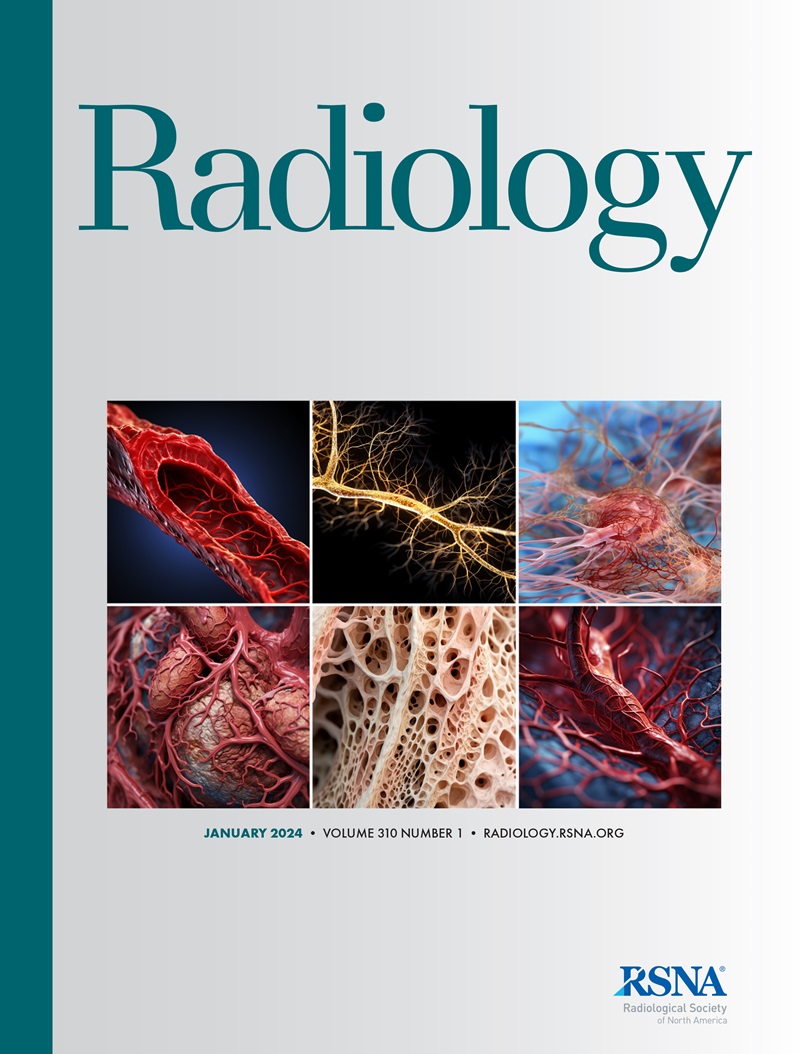MRI-based Radiomic Features for Risk Stratification of Ductal Carcinoma in Situ in a Multicenter Setting (ECOG-ACRIN E4112 Trial).
IF 12.1
1区 医学
Q1 RADIOLOGY, NUCLEAR MEDICINE & MEDICAL IMAGING
Kalina P Slavkova, Ruya Kang, Anum S Kazerouni, Debosmita Biswas, Vivian Belenky, Rhea Chitalia, Hannah Horng, Michael Hirano, Jennifer Xiao, Ralph L Corsetti, Sara H Javid, Derrick W Spell, Antonio C Wolff, Joseph A Sparano, Seema A Khan, Christopher E Comstock, Justin Romanoff, Constantine Gatsonis, Constance D Lehman, Savannah C Partridge, Jon Steingrimsson, Despina Kontos, Habib Rahbar
求助PDF
{"title":"MRI-based Radiomic Features for Risk Stratification of Ductal Carcinoma in Situ in a Multicenter Setting (ECOG-ACRIN E4112 Trial).","authors":"Kalina P Slavkova, Ruya Kang, Anum S Kazerouni, Debosmita Biswas, Vivian Belenky, Rhea Chitalia, Hannah Horng, Michael Hirano, Jennifer Xiao, Ralph L Corsetti, Sara H Javid, Derrick W Spell, Antonio C Wolff, Joseph A Sparano, Seema A Khan, Christopher E Comstock, Justin Romanoff, Constantine Gatsonis, Constance D Lehman, Savannah C Partridge, Jon Steingrimsson, Despina Kontos, Habib Rahbar","doi":"10.1148/radiol.241628","DOIUrl":null,"url":null,"abstract":"<p><p>Background Ductal carcinoma in situ (DCIS) is a nonlethal, preinvasive breast cancer for which breast MRI is best suited for accurate disease extent characterization. DCIS is often overtreated, necessitating robust models for improved risk stratification. Purpose To develop logistic regression models using clinical and MRI-based radiomic features of DCIS and to evaluate the performance of such models in predicting disease upstaging at surgery and DCIS score. Materials and Methods This study is a secondary analysis of dynamic contrast-enhanced (DCE) MRI data from the Eastern Cooperative Oncology Group-American College of Radiology Imaging Network, or ECOG-ACRIN, E4112 trial. Primary analysis focused on predicting disease upstaging (<i>n</i> = 295), and secondary analysis focused on predicting DCIS score (<i>n</i> = 174). Radiologist-drawn lesion segmentations and publicly available Cancer Phenomics Toolkit, or CaPTk, software was used to compute 65 radiomic features. Participants were clustered into groups based on their radiomic features (ie, radiomic phenotypes), and principal component analysis was used to summarize the feature space. Clinical information and qualitative MRI features were available. Associations were tested using χ<sup>2</sup> and likelihood ratio tests. Data were split into training and test sets with a 3:2 ratio, and model performance was assessed on the test set using the area under the receiver operating characteristic curve (AUC). Results Data from 297 female participants with median age of 60 years (IQR, 51-67 years) were analyzed. Two radiomic phenotypes were identified that were associated with disease upstaging (<i>P</i> = .007). For predicting disease upstaging, the top three radiomic principal components combined with clinical and qualitative MRI predictors yielded the highest AUC of 0.77 (95% CI: 0.65, 0.88) among all tested models (<i>P</i> = .007), identifying 25% more true-negative (49 of 93 true-negative findings, 53% specificity) findings, compared with using clinical information alone (23 of 93 true-negative findings, 28% specificity). Radiomic models were not predictive of the DCIS score (<i>P</i> > .05). Conclusion In patients with DCIS, combining radiomic metrics with clinical information improved prediction of disease upstaging but not DCIS score. ClinicalTrials.gov Identifier: NCT02352883 <i>Supplemental material is available for this article.</i> ©RSNA, 2025 See also the editorial by Kim and Woo in this issue.</p>","PeriodicalId":20896,"journal":{"name":"Radiology","volume":"315 1","pages":"e241628"},"PeriodicalIF":12.1000,"publicationDate":"2025-04-01","publicationTypes":"Journal Article","fieldsOfStudy":null,"isOpenAccess":false,"openAccessPdf":"","citationCount":"0","resultStr":null,"platform":"Semanticscholar","paperid":null,"PeriodicalName":"Radiology","FirstCategoryId":"3","ListUrlMain":"https://doi.org/10.1148/radiol.241628","RegionNum":1,"RegionCategory":"医学","ArticlePicture":[],"TitleCN":null,"AbstractTextCN":null,"PMCID":null,"EPubDate":"","PubModel":"","JCR":"Q1","JCRName":"RADIOLOGY, NUCLEAR MEDICINE & MEDICAL IMAGING","Score":null,"Total":0}
引用次数: 0
引用
批量引用
Abstract
Background Ductal carcinoma in situ (DCIS) is a nonlethal, preinvasive breast cancer for which breast MRI is best suited for accurate disease extent characterization. DCIS is often overtreated, necessitating robust models for improved risk stratification. Purpose To develop logistic regression models using clinical and MRI-based radiomic features of DCIS and to evaluate the performance of such models in predicting disease upstaging at surgery and DCIS score. Materials and Methods This study is a secondary analysis of dynamic contrast-enhanced (DCE) MRI data from the Eastern Cooperative Oncology Group-American College of Radiology Imaging Network, or ECOG-ACRIN, E4112 trial. Primary analysis focused on predicting disease upstaging (n = 295), and secondary analysis focused on predicting DCIS score (n = 174). Radiologist-drawn lesion segmentations and publicly available Cancer Phenomics Toolkit, or CaPTk, software was used to compute 65 radiomic features. Participants were clustered into groups based on their radiomic features (ie, radiomic phenotypes), and principal component analysis was used to summarize the feature space. Clinical information and qualitative MRI features were available. Associations were tested using χ2 and likelihood ratio tests. Data were split into training and test sets with a 3:2 ratio, and model performance was assessed on the test set using the area under the receiver operating characteristic curve (AUC). Results Data from 297 female participants with median age of 60 years (IQR, 51-67 years) were analyzed. Two radiomic phenotypes were identified that were associated with disease upstaging (P = .007). For predicting disease upstaging, the top three radiomic principal components combined with clinical and qualitative MRI predictors yielded the highest AUC of 0.77 (95% CI: 0.65, 0.88) among all tested models (P = .007), identifying 25% more true-negative (49 of 93 true-negative findings, 53% specificity) findings, compared with using clinical information alone (23 of 93 true-negative findings, 28% specificity). Radiomic models were not predictive of the DCIS score (P > .05). Conclusion In patients with DCIS, combining radiomic metrics with clinical information improved prediction of disease upstaging but not DCIS score. ClinicalTrials.gov Identifier: NCT02352883 Supplemental material is available for this article. ©RSNA, 2025 See also the editorial by Kim and Woo in this issue.
基于mri的多中心原位导管癌风险分层的放射学特征(ECOG-ACRIN E4112试验)。
导管原位癌(DCIS)是一种非致死性、侵袭前性乳腺癌,乳房MRI最适合准确的疾病范围表征。DCIS经常被过度治疗,需要健全的模型来改善风险分层。目的建立基于临床和mri的DCIS放射学特征的logistic回归模型,并评估该模型在预测手术期疾病和DCIS评分方面的性能。材料和方法本研究是对来自东部肿瘤合作组织美国放射学成像网络学院(ECOG-ACRIN) E4112试验的动态对比增强(DCE) MRI数据的二次分析。主要分析集中于预测疾病晚期(n = 295),次要分析集中于预测DCIS评分(n = 174)。使用放射科医师绘制的病变分割和公开可用的癌症表型学工具包(CaPTk)软件计算65个放射学特征。根据参与者的放射组学特征(即放射组学表型)将其聚类,并使用主成分分析来总结特征空间。临床资料和定性MRI特征可用。采用χ2和似然比检验检验相关性。将数据按3:2的比例分成训练集和测试集,使用受试者工作特征曲线下面积(AUC)在测试集上评估模型的性能。结果分析了297名中位年龄为60岁(IQR, 51-67岁)的女性参与者的数据。确定了两种与疾病晚期相关的放射组表型(P = .007)。对于预测疾病晚期,在所有测试模型中,前三个放射学主成分结合临床和定性MRI预测因子产生了最高的AUC,为0.77 (95% CI: 0.65, 0.88) (P = .007),与单独使用临床信息(93个真阴性结果中的23个,28%特异性)相比,确定了25%的真阴性结果(93个真阴性结果中的49个,53%特异性)。放射组学模型不能预测DCIS评分(P < 0.05)。结论在DCIS患者中,将放射组学指标与临床信息相结合可以改善疾病晚期的预测,但不能改善DCIS评分。ClinicalTrials.gov标识符:NCT02352883本文提供补充材料。©RSNA, 2025参见本期Kim和Woo的社论。
本文章由计算机程序翻译,如有差异,请以英文原文为准。

 求助内容:
求助内容: 应助结果提醒方式:
应助结果提醒方式:


